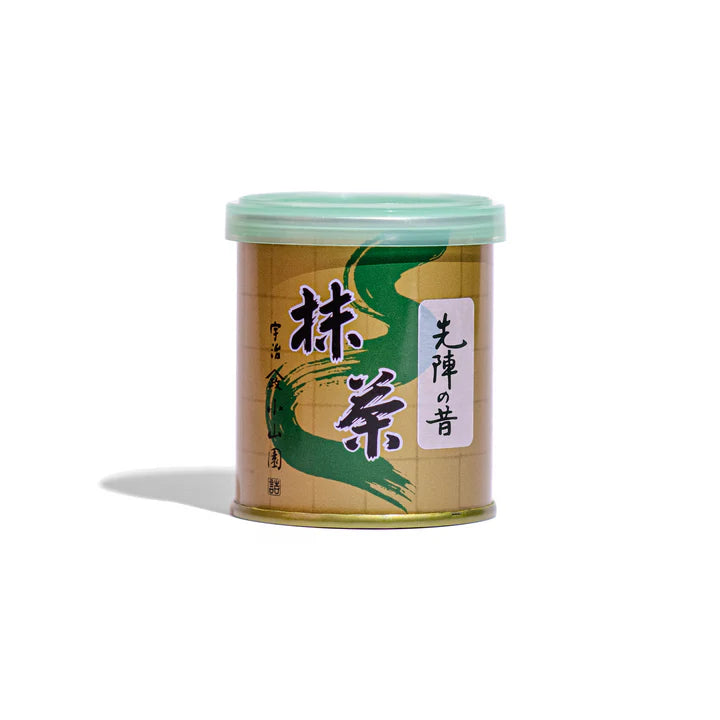Yamamasa Koyamaen
Matcha Senjin no Mukashi 30g Yamamasa Koyamaen
Matcha Senjin no Mukashi 30g Yamamasa Koyamaen
Couldn't load pickup availability
Product Description
Koicha grade Uji matcha. Recommended to make usucha (thin tea) or koicha (thick tea) as well.
Matcha "Senjin no Mukashi" is not only rich in flavour and covering aroma (the rich aroma unique to Oshishita tea), but also has a nice aroma (mil bud aroma) due to the use of young buds, making it delicious to drink.
We recommend Senjin no Mukashi and above as a grade that can be used as thick tea at tea ceremonies.
The meaning of Senjin no Mukashi "先陣の昔" :
"Senjin" is the Japanese word for "vanguard" - the first to arrive, the first to move foward, the ones that are placed in front or ahead of the rest.
◆The general notes of the usage of "mukashi" and "shiro":
The expressions "Mukashi" and "Shiro" at the end of tea names have a grading connotation and are used to distinguish between thick and thin teas, respectively.
Only "Mukashi" was likely to have been used originally, with the expression "Shiro” coming into use later on.
"Mukashi" is said to be a combination of the Chinese characters for "twenty" (廿) and "day" (日). Crucially, March 20th (廿日) of the lunar calendar is when it was said that the very best tea is picked.
"Shiro" became common during the reign of the third shogun, Tokugawa Iemitsu, and is said to have originated when the feudal lords of the time actively asked Uji tea masters to make their tea “thin" or "light". It is not clear what the expression “shiro" specifically meant at that time, but it is thought to have referred to the differences in taste, as records show that Furuta Oribe preferred dark green tea while Kobori Enshu preferred it to be lighter.
Perhaps the difference between 'dark' and 'light' tea can also be explained by the difference in the preparation methods of the tea in Uji.
Yamamasa Koyamaen’s entry-level koicha tea is a pleasantly full-bodied composition with a mild flavour. When made as a thick tea (koicha), it offers a blend of full-bodied, sweet and slightly astringent notes, whilst its aftertaste boasts intense green flavours as well as hints of toasted seeds and roasted coffee beans. When drunk as a thin tea (usucha), it offers a range of light, pleasantly creamy sweet flavours, making it far more transparent and ethereal compared to the next tea on our list, Shikibu no Mukashi. Use 95°C water to make koicha tea and 80-85°C water for usucha tea.
About Yamamasa Koyamaen
Yamamasa Koyamaen, rooted in the Uji-Okura region since the Edo period, has mastered tea cultivation and production for generations. Renowned for its superior tea cultivars, the company has been honored with 18 distinguished tea names by grand masters of Japanese tea ceremony schools. A leader in premium teas like matcha, gyokuro, and sencha, Yamamasa Koyamaen supplies retailers and businesses worldwide. Celebrating 160 years in 2021, the company ensures unmatched quality by overseeing every step of production, from cultivation to grinding.
Product Specifications
Name: Matcha
Ingredients: Green tea (Made in Japan)
Contents: 30g
Best before date: Approximately 4 months from date of manufacture
Storage method: Store in the refrigerator or in a cool, dark place, and be careful of moisture and odor transfer.
Manufacturer: Yamamasa Koyamaen Co., Ltd.
96 Kubo, Ogura-cho, Uji, Kyoto
Notes: [Precautions for use]
Matcha is a food that changes color quickly and is sensitive to high temperatures, high humidity, sunlight, and odor transfer. Please handle with care.
- Lower temperatures are more effective for maintaining quality. We recommend storing in the refrigerator or freezer. When using, return the container to room temperature completely before opening to prevent condensation due to temperature differences.
- If the container is not tightly sealed after opening and stored in the refrigerator, it may cause rapid deterioration in quality due to unpleasant odors and condensation due to temperature differences. Store in a sealed container at room temperature and use as soon as possible.
- Matcha is very fine-grained and tends to clump due to static electricity. We recommend sifting it through a sieve before use. Because it is prone to absorbing moisture and water, matcha sprinkled on Japanese and Western sweets may become wet (crying) over time.
・Yamamasa Koyamaen's matcha contains no additives and is a natural green color. When heated, the flavor deteriorates and the color may turn reddish. Also, if displayed in a showcase for an extended period of time, the color may fade due to exposure to light.
・To maintain quality, oxygen absorbers are sealed inside the cans and bags. If you are adding bagged matcha directly to the work process, please be careful not to add the oxygen absorber by mistake. The oxygen absorber is made of packaging material that is harmless even if it comes into direct contact with matcha.
Share












